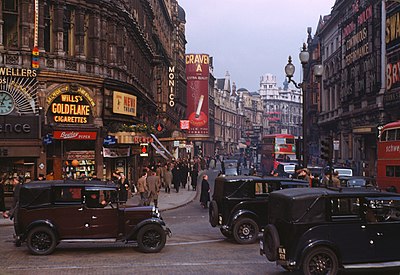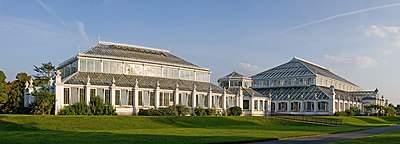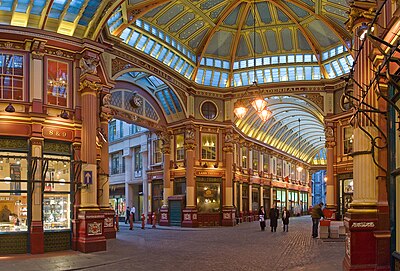Featured pictures

These are featured pictures related to London which appear on Portal:London.
For a complete gallery of featured pictures related to London, click here.

Photo credit: David Iliff
The three tallest skyscrapers in Canary Wharf, a large business and shopping development in the London Borough of Tower Hamlets, as viewed from Cabot Square: 8 Canada Square (centre-left), One Canada Square (centre), Citigroup Centre (centre-right). 
Photo credit: Chalmers Butterfield
Shaftesbury Avenue from Piccadilly Circus, in the West End, c. 1949. The Circus, a famous traffic intersection and public space in the City of Westminster was built in 1819 to connect Regent Street with the major shopping street of Piccadilly. Its status as a major traffic intersection has made it a busy meeting point and a tourist attraction in its own right. 
Photo credit: Andrew Dunn
The Queen Elizabeth II Great Court of the British Museum is a covered square designed by the architects Foster and Partners. It opened in December 2000 and is the largest covered square in Europe. The roof is a glass and steel construction with 1,656 pairs of uniquely shaped glass panes. At the centre of the Great Court is the British Museum Reading Room. 
Credit: Samuel Davenport, after William Hogarth
Gin Lane is one of a pair of 1751 engravings by William Hogarth in support of the then-proposed Gin Act 1751. This Act of Parliament made the distillation of gin illegal in England. Whereas its pendant Beer Street shows a happy city drinking the "good" beverage of English beer, Gin Lane claims to show what would happen if people started drinking gin, a harder liquor. The scene can be identified as taking place in St Giles, a slum district of London, from the presence of St George's Church, Bloomsbury, in the background. 
Photo credit: David Iliff
Built in 1859 and at 4,880 square metres (52,500 sq ft) in area, the Temperate House in Kew Gardens is the largest surviving Victorian glass structure in the world, and houses an extensive collection of temperate plants, including the world's largest indoor plant, the Chilean wine-palm. 
Photo credit: David Iliff
30 St Mary Axe, otherwise known as "The Gherkin" or the Swiss Re building, at 180 m (590 ft) is the 6th tallest in London, England. Designed by Foster and Partners, the architectural design of the tower contrasts sharply against more traditional buildings in London, such as the Church of St Andrew Undershaft in this photograph. 
Photo credit: David Iliff
Leadenhall Market is a covered market that dates back to the 14th century in the City of London, located in Gracechurch Street. The ornate roof structure of the current building, designed in 1881 by Sir Horace Jones, and painted green, maroon, and cream, makes the building a tourist attraction. 
Photo credit: David Iliff
The platform at Clapham Common, a station on London Underground's Northern line. With tracks on either side serving trains moving in opposite directions, this is an example of an island platform. 
Photo credit: David Iliff
The Tower Bridge is a bascule bridge that crosses the River Thames. It was completed in 1894 and the original hydraulic machinery still opens the bridge, although it has been modernised. The central span of 200 feet (61 m) between the towers is split into two equal bascules or leaves, which can be raised to an angle of 83 degrees to allow river traffic to pass. The high-level walkways between the towers house an exhibition on the bridge's history. 
Photo credit: David Iliff
The London Eye from Jubilee Gardens, on the South Bank of the River Thames in the London Borough of Lambeth. At 135-metre (443 ft) tall it is the tallest Ferris wheel in Europe, and the most popular paid tourist attraction in the United Kingdom, visited by over 3.5 million people annually. When erected in 1999, it was the tallest Ferris wheel in the world. 
Photo credit: David Iliff
The Royal Albert Hall, as viewed from the Albert Memorial in Kensington Gardens. The Royal Albert Hall, built 1867–71, is a concert hall in South Kensington best known for holding the annual summer Proms concerts since 1941. With the Albert Memorial the Hall forms part of the national memorial to Prince Albert, consort of Queen Victoria. 
Photo credit: David Iliff
The City of London skyline, as viewed toward the northwest from the top floor viewing platform of City Hall on the southern side of the River Thames, in 2008. Not to be confused with the London metropolitan area, the City covers 1.12 sq mi (2.90 km2) and, along with Westminster is the historic core of London around which the modern conurbation grew. 
Photo credit: Colin
The western departures concourse of King's Cross railway station. Designed by John McAslan, it opened in 2012. The architect claims that the roof is the longest single-span station structure in Europe. 
Photo credit: Library of Congress / Durova (restored by Adam Cuerden)
Vauxhall Gardens, depicted here in a print after Thomas Rowlandson, was a pleasure garden in Vauxhall, South London. It was one of the leading venues for public entertainment in London from the mid-17th to the mid-19th century. The figures in the print include George IV and his mistress Mary Robinson, the socialite Georgiana Cavendish, Duchess of Devonshire, and the luminaries Samuel Johnson, James Boswell, Hester Thrale and Oliver Goldsmith. 
Photo credit: David Iliff
The Albert Memorial is situated in Kensington Gardens, directly to the north of the Royal Albert Hall. It was commissioned by Queen Victoria in memory of her beloved husband, Prince Albert, who died of typhoid in 1861. The memorial was designed by Sir George Gilbert Scott in the Gothic Revival style; the form is intended to evoke an ornate medieval ciborium over the high altar of a church. 
Photo credit: Colin
St James’s Park Lake, looking east from the Blue Bridge towards Whitehall and beyond to the London Eye. St James’s Park is the oldest of the Royal Parks of London and lies at the southernmost tip of the area of St James's.